




Aivazovsky
For over a hundred years Ivan Aivazovsky has been one of Russia's most popular artists, enjoying even in his youth greater fame than most artists do in a lifetime. His name was well known to fellow artists, whom he thrilled by his talent, and to the public at large. Indeed, his fame spread with incredible rapidity. While still a young man, he was elected to various foreign academies and eventually became the second Russian artist (after Orest Kiprensky) to earn the honour of having his self-portrait displayed in the Pitti Gallery in Florence.
Aivazovsky's success was well-earned, for no other artist managed to capture with such brilliance, conviction and apparent ease that most difficult of subjects for the painter- the changing moods of the sea.
Aivazovsky was not merely a professional marine painter. He knew and loved the sea, but he did not limit himself exclusively to seascape painting; and if he turned to other art forms, such as landscape and portraiture, these were only brief departures from his chosen subject to which he remained faithful all his life.
When he began his career, Russian art was still dominated by Romanticism and it was the romantic mood which set the terms for Russian landscape painting in the latter half of the nineteenth century. It is scarcely surprising, then, to discover romantic elements both in his early works and in the majority of his later canvases, as reflected in his choice of subjects: again and again we find him depicting shipwrecks, raging sea battles and storms.
Continuing in the tradition of the great Russian landscape painters of the early nineteenth century without recourse to imitation, he started a new tradition or school of painting, thus leaving his own impress on the marine painting of his own and later generations. His works reflect, moreover, the national traits and ancient culture of the Armenian people, whose loyal son he remained to the end of his days.
Apart from his work as an artist, Aivazovsky was a tireless and versatile public figure: he took a lively interest in world events and sympathized deeply with the lesser nations in their struggle for independence. At the same time he worked selflessly for the good of his native town of Theodosia and did much to assist the younger generation of artists.
Aivazovsky was born on 17 July 1817 (29 July New Style) in the ancient Crimean town of Theodosia, where his father, an Armenian by nationality, had settled at the turn of the century. His father was a relatively well-educated man who knew several oriental languages, and who, though a trader of small means, played a significant part in the commercial life of the town. Unfortunately the plague epidemic that swept Theodosia in 1812 wrecked his business, and when Ivan was born the family had fallen on really hard times. There is some evidence to suggest that poverty obliged young Aivazovsky to work in Theodosia's cosmopolitan coffee-shops, babels of diverse tongues: Italian, Greek, Turkish, Armenian and Tartar. The boy's eager mind soaked up all the colourful sights and sounds which Theodosia with its mixed population had to offer. He also had a keen musical ear and soon learned to play folk melodies on the violin. In later years he would play these melodies of his boyhood to his friend Mikhail Glinka, the composer, who used them in his compositions. It was drawing, however, that really captured his imagination: lacking other materials he used to draw with charcoal on the whitewashed walls of the town. These drawings attracted the attention of Mayor A. Kaznacheyev, who helped Aivazovsky enter the Simferopol gymnasium and, in 1833, the St Petersburg Academy of Arts.
Aivazovsky's student years in St Petersburg coincided with a confused and in many ways contradictory phase in Russian history. On the one hand, it was a period of harsh tyrannical rule and political stagnation under Tsar Nicholas I, on the other, it witnessed a remarkable flowering of Russian culture after the Napoleonic War of 1812. This was the age of Pushkin, Gogol, Lermontov, Belinsky, Glinka and Briullov. Within the Academy, the canons of Classicism, closely linked to the ideas of civic duty and patriotism, still held sway, but the new stirrings of Romanticism were also discernible.
The great success of Karl Briullov's picture The Last Day of Pompeii made a permanent impression on Aivazovsky, marking as it did the victory of the Romantic school of Russian painting. Both the picture and Briullov himself did much to stimulate Aivazovsky's own creative development. Besides, the spirit of the Romantic school was inculcated in Aivazovsky by M. Vorobyov, his teacher in the Academy landscape class. In general, Russian art of the first half of the nineteenth century mixed Romanticism with Realism and very often both principles found expression in the work of a single artist. This was especially evident in the case of such an essentially realist art form as landscape painting, where romantic features persisted for a long time. Aivazovsky acquired a romantic outlook in his student years and maintained it in maturity. He remained to the end one of the most faithful disciples of Romanticism, although this did not prevent him from evolving his own form of realism.
In 1836, acting on the advice of A. Sauerweid, his teacher in the battle-painting class of the Academy, Aivazovsky was a guest at the Baltic Sea Fleet manoeuvres. Sauerweid hoped that his pupil would follow in his footsteps and specialize in naval battle scenes. That same autumn Aivazovsky's works appeared in the Academy exhibition. These student sketches already showed signs of outstanding talent and a mastery quite remarkable for someone in only his second year at the Academy.
"Aivazovsky's pictures... show without a doubt that his talent will take him far. Study of nature will reveal to him more treasures, whose existence his talent scarcely suspects at present," wrote The Art Gazette, noting the artist's "inherent poetic gift". One of Aivazovsky's early canvases, The Great Roads. Kronstadt, is reproduced in the present book. Although the foreground of the picture with its naively drawn human figures recalls the old Dutch masters, the perspective has breadth and depth, with the soggy clouds drifting away into the distance. Even though the waves appear to be arrested in their wind-driven course, the painter has captured the cold spirit of the hostile Baltic.
In October 1837 Aivazovsky completed his studies at the Academy and received the gold medal that gave him the right to a prolonged course of study abroad at the expense of the Academy. Bearing in mind the peculiar nature of Aivazovsky's gift, the Council of the Academy made an unusual decision. To begin with, the artist was to spend two summers in the Crimea, where he was to perfect himself in his chosen genre by painting views of the coastal towns, sending his works at the end of the year to the Academy. Only after that was he to leave for Italy.
Once back in Theodosia, Aivazovsky lost no time in setting to work. Indeed, his capacity for work was always a matter of wonder to those who knew him, and soon a whole succession of Crimean views had come off his easel.
While still a student, Aivazovsky had been attracted by the romance of naval battles and the proud beauty of sailing ships. His work in Sauerweid's class and participation in the manoeuvres of the Baltic Sea Fleet had encouraged him still further. In the Crimea Aivazovsky profited by the chance to return to his favourite theme. N. Rayevsky, the commander of the Caucasus Coast Line, suggested that he take part in the Black Sea Fleet manoeuvres, and during 1839 he went to sea three times, painted a great deal from nature, and made the acquaintance of Admirals Lazarev, Kornilov and Nakhimov. The Russian navy welcomed him with open arms and thereafter treated him-man and artist- with the greatest consideration.
In the summer of 1840, before setting off on his scholarship journey, Aivazovsky returned to St Petersburg. By September he found himself in Rome where, as in St Petersburg, he made the acquaintance of some of the outstanding men of his time. He became friendly with Nikolai Gogol and was on good terms with Alexander Ivanov and other Russian artists living in Rome. As usual, friendly relations with some of his gifted contemporaries had a beneficial effect on his work.
He worked industriously, and his pictures appeared regularly in Italian exhibitions, bringing him unusual renown. News of this reached St Petersburg, and The Art Gazette published a long article on his success in Italy, running, in part, as follows: "Aivazovsky's pictures in Rome are judged the best in the exhibition. His Neapolitan Night, The Storm and Chaos have caused such a sensation in that Capital of the Fine Arts that the palaces of noblemen and society venues are all astir with the fame of the landscape painter from southern Russia: the newspapers have sung his praise loudly and all agree that only Aivazovsky depicts light, air and water so truthfully and convincingly. Pope Gregory XVI has purchased his Chaos and had it hung in the Vatican, where only the works of the world's greatest artists are considered worthy of a place. His Chaos is generally held to be quite unlike anything seen before; it is said to be a miracle of artistry."
During a trip to Italy in 1842, the famous English marine painter, Joseph Turner, was so struck by Aivazovsky's Bay of Naples on a Moonlit Night, that he dedicated to him a rhymed eulogy in Italian:
In this your picture I see the moon, all gold and silver Reflected in the sea below... And on the surface of the sea There plays a breeze which leaves a trail Of trembling ripples, like a shower Of fiery sparks or else the gleaming headdress Of a mighty king! Forgive me if I err, great artist, Your picture has entranced me so, Reality and art are one, And I am all amazement. So noble, powerful is the art That only genius could inspire!
Leading artists praised Aivazovsky, others frankly began to imitate him. In Italy, where marine painting was unknown, seascapes began to appear in large numbers in art shops.
Aivazovsky enjoyed equal success when, in 1842, with the permission of the Academy, he exhibited his works in Paris. The Council of the Paris Academy awarded him first their gold medal, then, in 1857, the Legion of Honour-an order rarely conferred on foreigners. Horace Vernet, the well-known French battle-painter, declared to Aivazovsky that his talent was a. credit to his native land.
How did it happen, one may ask, that Aivazovsky entranced connoisseurs and ordinary art-lovers alike? Turner partially answered this question in his poem: it was Aivazovsky's unusual fidelity to nature which amazed those who viewed his pictures; it was his ability to convey the effect of flowing water and reflected sunshine or moonlight. In short, it was his accurate and at the same time highly charged and dramatic depiction of the sea. However, Aivazovsky took some time to discover the secret of creating such impressive images. All his student years and the beginning of his foreign scholarship had been devoted to the pursuit of this technique.
It is interesting to compare Aivazovsky with the Russian artist Sylvester Shchedrin, who had died in Italy only ten years before Aivazovsky set foot on Italian soil. Shchedrin had broken with the academic tradition of conventional landscape in the 1820s. His pictures had been painted directly from life and combined severe realism with a certain sense of poetry. Shchedrin was idolized by those young artists who yearned to achieve truth in their art. Aivazovsky's favourite subject-matter was very close to that of Shchedrin, and it was his aim to follow in Shchedrin's footsteps.
The underlying principle of Shchedrin's endeavour was to paint strictly from life. This was how Aivazovsky had painted in the Crimea and the way he had begun to paint in Italy. Wishing to discover the secret of Shchedrin's art, he even tried painting a landscape from the exact spot Shchedrin had chosen (The Coast near Amalfi). However, being a man of different temperament and a product of another century, Aivazovsky could not become another Shchedrin. A picture might be accurate and exact but deprived of life. The viewer would see familiar places and painstakingly reproduced details, but would remain indifferent to what he saw. Instead of painting direct from nature, therefore, Aivazovsky tried painting a picture of the restless sea from memory, in his studio; and lo!- a miracle happened-there, sparkling and shimmering, was the sea: he had discovered for himself the secret of depicting nature from memory, even without preliminary studies.
Justifying his method theoretically, Aivazovsky wrote: "The movement of the elements cannot be directly captured by the brush-it is impossible to paint from nature a flash of lightning, a gust of wind, or the splash of a wave. For that the artist must retain the impression they had left upon him..."
Aivazovsky's phenomenal memory and romantic imagination enabled him to employ this method with unsurpassed brilliance. At the same time, the speed and ease with which he painted caused him to repeat himself, occasionally allowing elements of cliche and salon prettiness to creep in. With his training in the Academy, Aivazovsky could not entirely free himself of the tendency to "improve" on reality. On the whole, however, the method he had invented served his creative idiom and conformed with the spirit of the times. Very soon he reached the peak of his fame.
In 1844 Aivazovsky obtained permission to end his European tour earlier than planned and he set off for Russia via Holland. In Amsterdam he organized an exhibition of his pictures, which proved a great success, and the Amsterdam Academy honoured him with the title of academician. In St Petersburg, the Council of the Academy also bestowed on him the title of academician, and by the Tsar's edict he was attached to the Chief Naval Staff "with the title of painter to the Staff and with the right to wear the uniform of the naval ministry". Right away Aivazovsky was commissioned to paint views of Kronstadt, Revel (now Tallinn) and other places on the Baltic coast. By the end of the winter he had completed the commission. The result was a series of large-scale canvases in which he succeeded in combining accurate topographical information with a poetic mood.
In the spring of 1845 Aivazovsky set off on a voyage skirting the coasts of Asia Minor and the Greek islands on board a ship commanded by Admiral Liitke, a noted scholar and founder of the Russian Geographical Society. Once again Aivazovsky plunged into intensive work and his sketch-books were soon filled with new impressions. On his return he settled in the Crimea to paint Black Sea coastal scenery and towns he had visited during the recent voyage. The pictures of this period are among his best, especially those in which he depicts Constantinople and Odessa. Here, in the shimmering gold of sky and water, in the moonlit buildings and romantic statues, indeed in his whole colour scheme, we find that same vision of the beautiful and exotic South which inspired many of Pushkin's poems. Aivazovsky, then a youth, had been introduced to Pushkin at the Academy exhibition of 1836 and he revered the poet all his life. Several times he painted Pushkin standing on the seashore. The best of these pictures was the one painted jointly with Ilya Repin.
By the mid-1840s Aivazovsky had begun thinking of settling permanently in Theodosia, since the role of court painter held little attraction for him. He preferred to work steadily at his paintings in a peaceful provincial seaside town; and here, in Theodosia, he remained to the end of his life. He travelled to St Petersburg occasionally and visited Moscow from time to time; he made journeys to the Caucasus, along the Volga, to Turkey and to America, and his exhibitions scored success wherever he went; but Theodosia always remained his real home. It was there that he produced his best canvases.
Some forty years after settling in Theodosia, he financed the foundation there of the picture gallery which bears his name. It now houses 130 canvases and 270 sketches belonging to his brush, as well as works by Lagorio, Vessler, Latri, Voloshin, Bogayevsky and other artists connected with the eastern Crimea, a region of ancient culture and picturesque though stern scenery.
Aivazovsky's links with the Russian Navy grew ever stronger. He was admired by the Navy in a way unparalleled in the history of art. In 1846, for example, when the Navy celebrated the tenth anniversary of Aivazovsky's artistic career, Admiral Kornilov sent a special squadron of battleships from Sevastopol to congratulate the artist.
The years 1846-48 witnessed a series of outstanding canvases devoted to battles at sea, all based on the heroic past of the Russian fleet. These pictures bear no trace of the cliches usually adopted by official battle-artists; they convey the spirit of excitement and romantic uplift evoked in the artist's mind by scenes of deadly combat. This is particularly evident in the dramatic picture entitled The Battle of Chesme, depicting a sea battle at night. The defeated Turkish fleet set on fire by a Russian fire-ship is an unusually impressive spectacle, Aivazovsky's mastery of light effects being used to the full. Flames reflected in the heavy clouds vie with moonlight and the tall columns of smoke rising into the sky. Smudges of crimson and black merge in the general confusion. It should be added that even in Aivazovsky's best pictures, elements of the academic tradition made themselves felt. Here they can be detected both in the spectacular panorama of the battle and in the conventional poses of Turkish sailors trying to keep afloat on fragments of their doomed ships.
Another of this group of pictures, entitled The Battle in the Straits of Chios, is full of inner tension. Here Aivazovsky very skilfully achieved the effect of depth by alternating the silhouettes of near and distant ships.
A third picture painted at the same time is The Brig "Mercury' where the battle is already over. A small ship with sails torn to shreds is returning to the main Russian fleet (visible on the horizon) from a successful, heroic raid.
By the 1850s the romantic element in Aivazovsky's work had become even more apparent. This is clearly seen in one of his best and most famous pictures, The Ninth Wave. A group of shipwrecked survivors are about to be engulfed by an enormous wave. The merciless pounding of the elements is brilliantly conveyed as the waves roll, rise and crash down with full force, revealing for a moment the deep troughs between them. The restless surge of clouds and sprays of foam strengthen the impression of a raging hurricane. Survivors still clinging to a broken mast continue struggling for their lives; the sun has just peeped out, piercing the watery chaos, raising their hope of survival. The essential tragedy element in the picture is outweighed by the vivid impression it makes: the spectator is stunned by the fury of the storm, yet his feelings are assuaged by the grandeur of the scene. This duality is typical of Aivazovsky, but it was present, too, in Briullov's famous picture The Last Day of Pompeii. There is an interval of seventeen years between The Last Day of Pompeii and The Ninth Wave and they differ widely in their genre as well as in their place in the history of Russian art; but stylistically they stand together and represent the rise of Romanticism both in the individual development of the two painters and in Russian art as a whole.
In the second half of the nineteenth century realistic trends became dominant in Russian culture and did not pass by Aivazovsky. The new spirit of conscious and consistent realism had its effect on his work as on that of many others, but his romantic inclinations persisted.
During the Crimean War of 1853-56 Aivazovsky spent some time in besieged Sevastopol, where he made some sketches. However, this war, fought mostly on land, found little reflection in his work, despite the fact that from this time non-maritime subjects attracted his attention more and more often. He knew well the endless Ukrainian steppes because he had often travelled over them on his journeys to St Petersburg, and their infinite expanses had fired his imagination. From now on we often find peasant carts and Ukrainian farm-houses in his pictures. During the 1860s many Russian artists of democratic inclination became interested in the peasant theme and it was probably this general trend that turned Aivazovsky's attention to that theme, though loyalty to the academic tradition in art kept him from filling his canvases with the tendentious social content and a sense of drama that characterized the true "men of the 'sixties". The pictures he painted at this time are not among his best.
In the 1860s Aivazovsky visited the Caucasus. The splendour of its mountain scenery made an indelible impression on him and he produced a whole series of pictures on Caucasian subjects. He had painted mountains before, usually with waves breaking on their gloomy cliffs, though mountains did appear more and more frequently in later years. Once again Aivazovsky found romance and drama in the clash of the elements-mountains and sea. In a picture depicting the аul (Caucasian village) of Gunib, the majestic reddish mountains of Daghestan rise like fantastic frozen waves. Everything conspires to give the picture a romantic quality: the darkness of the ravines, the misty background, the mounted tribesmen on the path. At the same time the picture is strictly documentary in that it records the actual contours of a real locality, and Aivazovsky underlined this fact by calling his canvas The Aul of Gunib in Daghestan. View from the East.
In the 1860s Aivazovsky turned to another subject close to his heart. In 1867 the Greeks living on Crete started a rebellion against Turkish rule. Ever since his childhood Aivazovsky had felt a sympathy for the Greeks in their struggle for liberation, and now he painted a picture called On the Island of Crete, capturing the dramatic moment when the rebels bid farewell special to their women and old folk being evacuated on a Russian ship. The mood of nature corresponds to the feelings of the people: over the sea there is a bright cloudless sky, but over the island the storm clouds thicken, darkening the valleys and ravines; the trees are bent by the wind-a storm is coming. Even a certain degree of melodrama in the depiction of the figures in the foreground does not reduce the overall air of tension and foreboding. In a way, this reflected Aivazovsky's own state, for at the age of fifty he was on the verge of a new upheaval in his artistic evolution.
The final third of the nineteenth century witnessed a flowering of realism in all spheres of Russian art. It was then that the members of the Society for Circulating Art Exhibitions (the Peredvizhniki) were creating their best works, and names like Repin, Kramskoi, Surikov, Shishkin and Levitan came to the fore. Aivazovsky's talent also took a new direction early in the 1870s. The somewhat sugary picturesqueness of his early works gave way to a more realist vision of the world. The romantic tension does not leave his pictures, but takes on a sterner, more restrained character. In The Rainbow (1873) the artist uses more subtle colouring, as if he had begun to look at the sea with new and more discerning eyes. The waves and spray-filled air are painted more authentically than ever.
At first sight there is nothing unusual in his Moonlit Sea (1878)-a full moon penetrating a thin film of clouds, its reflection stretching like a watery path broken by ripples, a mountain chain in the distance; yet all this is handled in a novel manner: the serried march of the seas is more intense, the sense of space stronger, the beauty of a southern night conveyed more subtly.
Aivazovsky's greatest achievement in this period is The Black Sea (1881). Here the artist created a generalized image of the marine elements in their ever-changing manifestations. The distant horizon is calm, but closer up the waves start rolling as the sea gets rougher. In the immediate foreground billows heave up, crested here and there with foam. Their measured undulations and the vastness of the sea are conveyed with exceptional power. So far the water has only begun to seethe, yet its motion is already relentless and frightening. The fine blue of the sky is receding before a dense grey wall of clouds; coloured shadows appear on the water with dappled patches and flecks of light-some blue, some turquoise or pure green-just as in real life. Ivan Kramskoi, who was a discerning and sensitive critic, wrote of this picture: "There is nothing in it but sky and water, yet the water is a boundless ocean, restless rather than rough, severe, infinite, and the sky is, if possible, still more infinite. It is one of the most striking pictures I have ever seen."
It is a rare artist who resists old age and actually rises above his previous works. Aivazovsky achieved this twice. He painted The Black Sea at the age of sixty-four and then produced the large-scale canvas Amidst the Waves when he was nearly eighty-two. In it he painted a complicated network of waves in an endless variety of grey, green and blue shades done in light, almost transparent brush-strokes. With inimitable skill he created an image of the ocean stirred up by a hurricane. Separated by deep abysses the waves thunder, collide and break into whirlpools. This vast body of water is in constant feverish motion undergoing endless transformations: here are elemental power and movement brought to the extreme. This final image of the angry but beautiful sea forms a fitting climax to the great artist's work.
Aivazovsky maintained his capacity for work, his energy and lively creative intelligence until the very end of his life. All in all he produced more than 6,000 pictures and a multitude of skilfully executed drawings and sketches. Many of his works have taken their place among the greatest achievements of visual art. Kramskoi referred to Aivazovsky as "a star of the first magnitude" and thus correctly established the painter's place in the pantheon of Russian art.
Fate was kind to Aivazovsky, endowing him with a clear mind and a noble soul. He worked all his life in congenial settings of his own choice; he received in his lifetime all the signs of official recognition which he deserved; his talent was universally acclaimed.
At his home in Theodosia Aivazovsky worked for the good of its inhabitants and the development of the region, taking his role very seriously. He supplied the town with water from his own estate, opened an art school, began the first archaeological excavations in the region, and built a historical museum. Finally, thanks to his efforts a commercial port was established at Theodosia and linked up to the railway network. By these and other generous deeds Aivazovsky earned the love and respect of the townspeople. To this day the principal sights of the town are his picture gallery and his tomb near an ancient Armenian church.
Aivazovsky died on 19 April (2 May New Style) 1900, on the verge of the twentieth century, leaving unfinished a picture he had begun that very day. Whatever the future of Russian art might be, there is no doubt that Aivazovsky's creative legacy will always be a treasured part of its history.
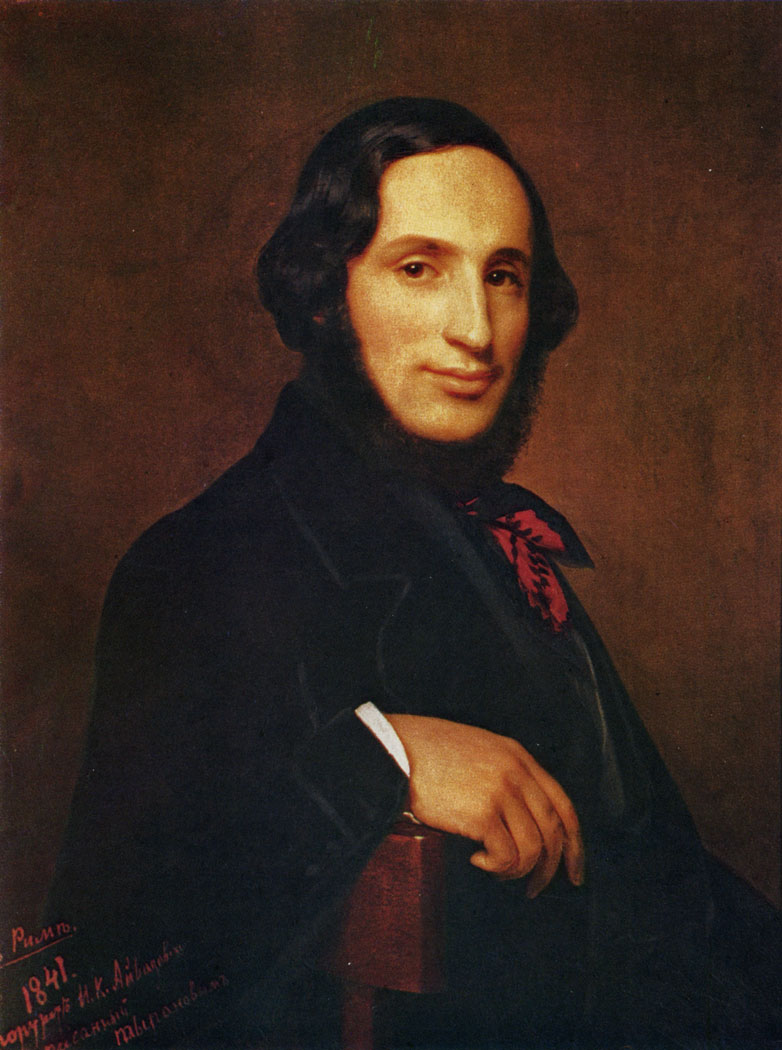
Portrait of Aivazovsky by A. Tyranov. 1841
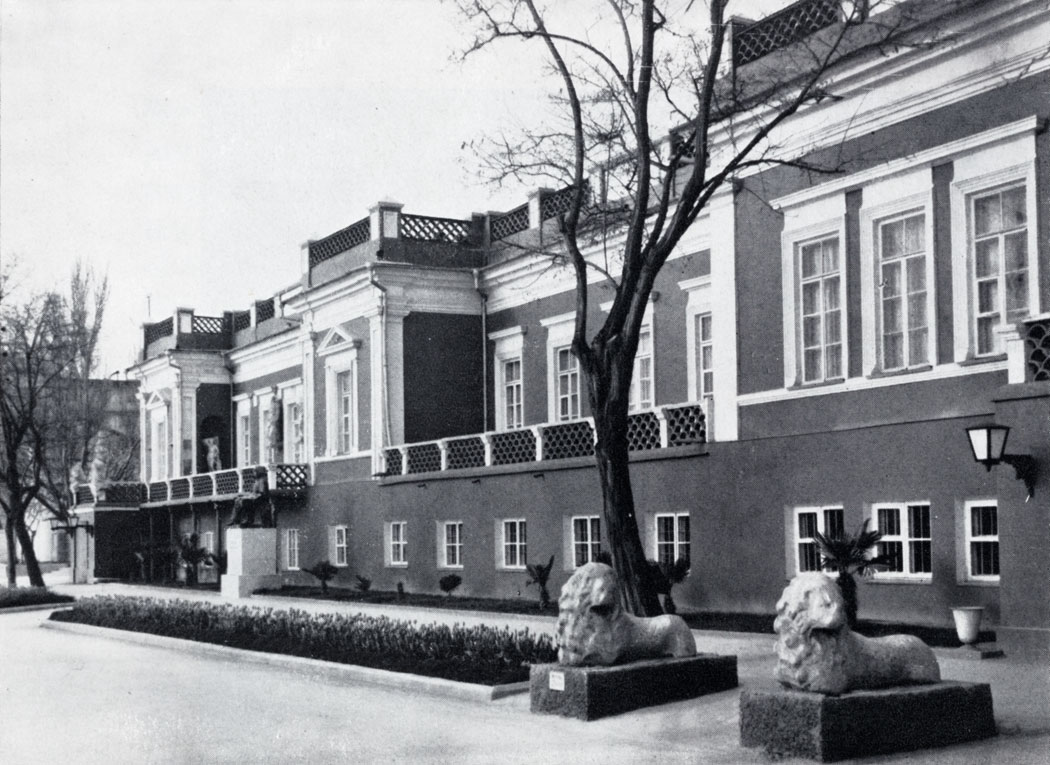
The Theodosia Picture Gallery Named after Aivazovsky
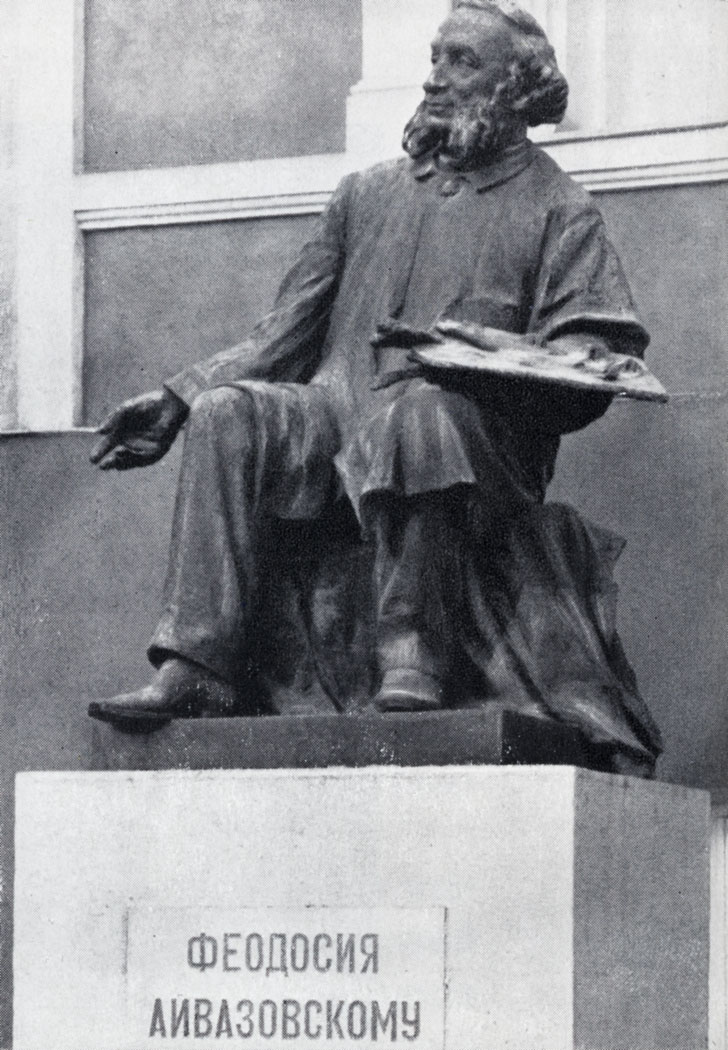
Monument to Aivazovsky in Theodosia
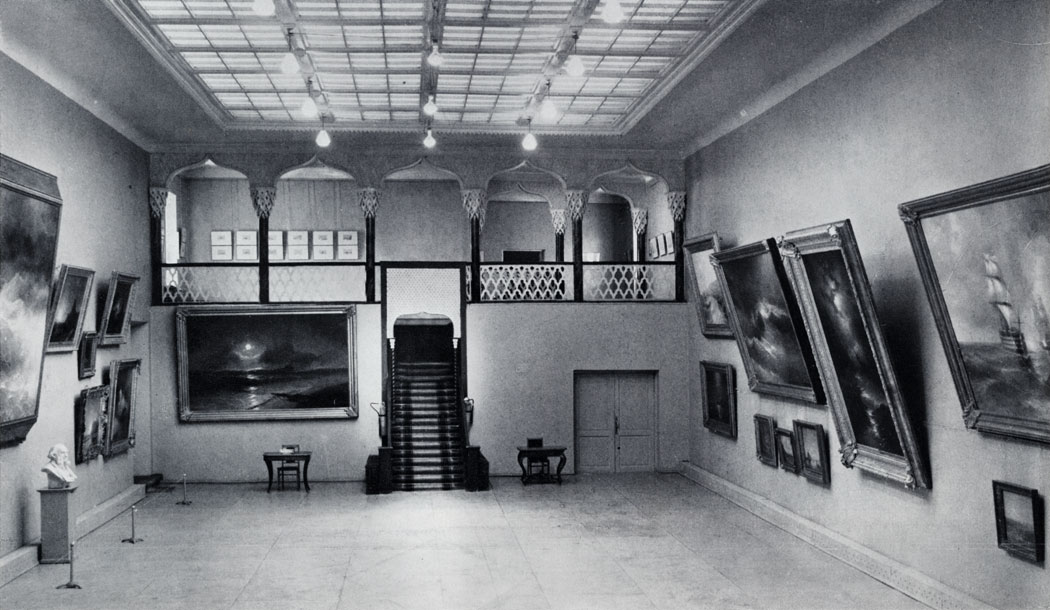
Main hall of The Picture Gallery in Theodosia
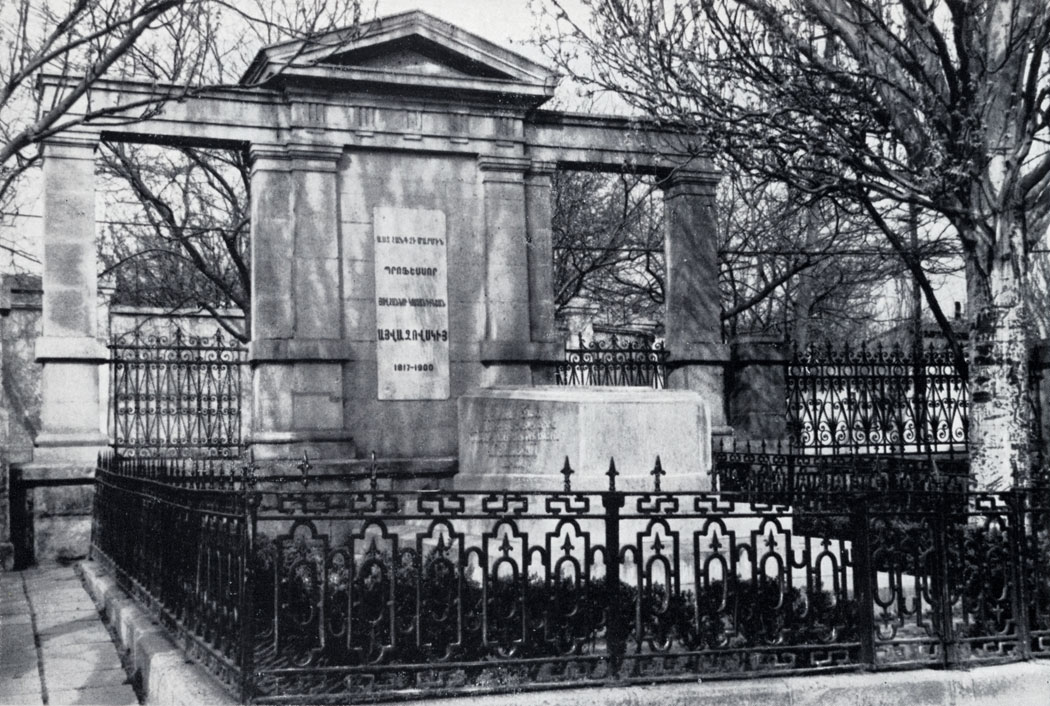
Aivazovsky's tomb in Theodosia
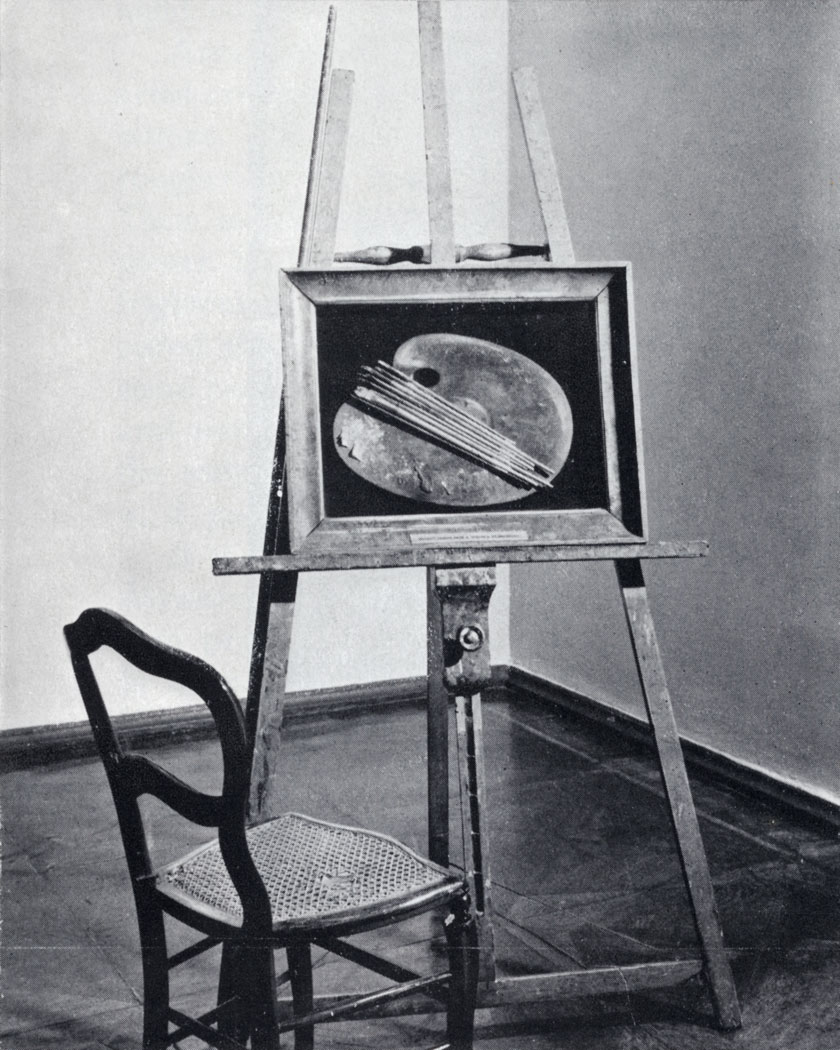
Aivazovsky's easel, palette and brushes
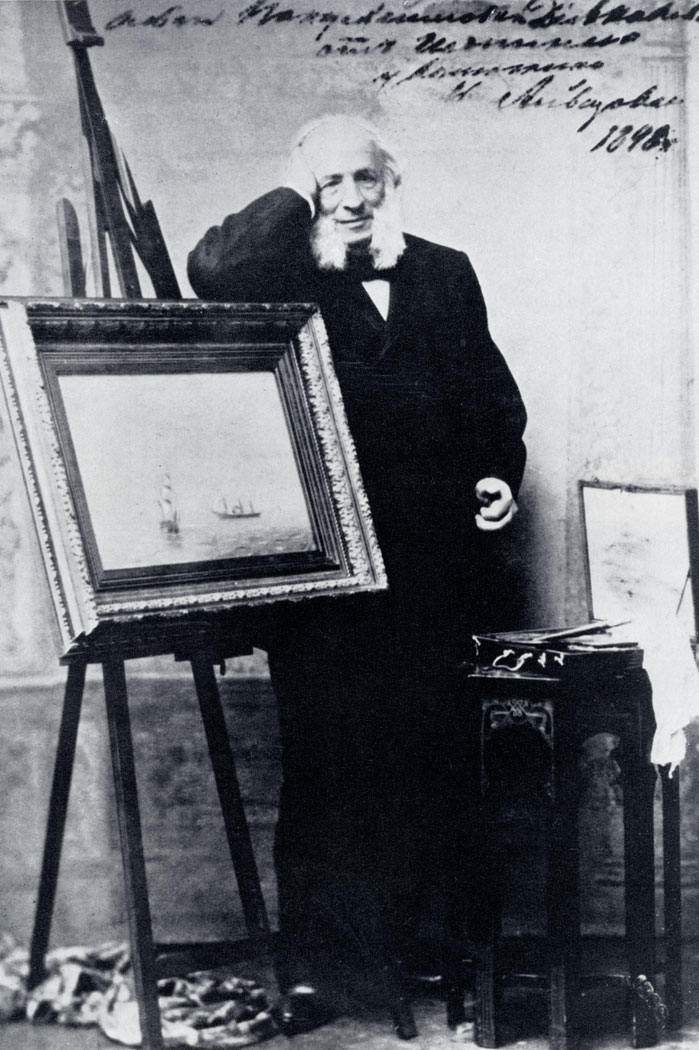
Aivazovsky. Photograph of 1898
|
ПОИСК:
|
© PAINTING.ARTYX.RU, 2001-2021
При использовании материалов сайта активная ссылка обязательна:
http://painting.artyx.ru/ 'Энциклопедия живописи'
При использовании материалов сайта активная ссылка обязательна:
http://painting.artyx.ru/ 'Энциклопедия живописи'